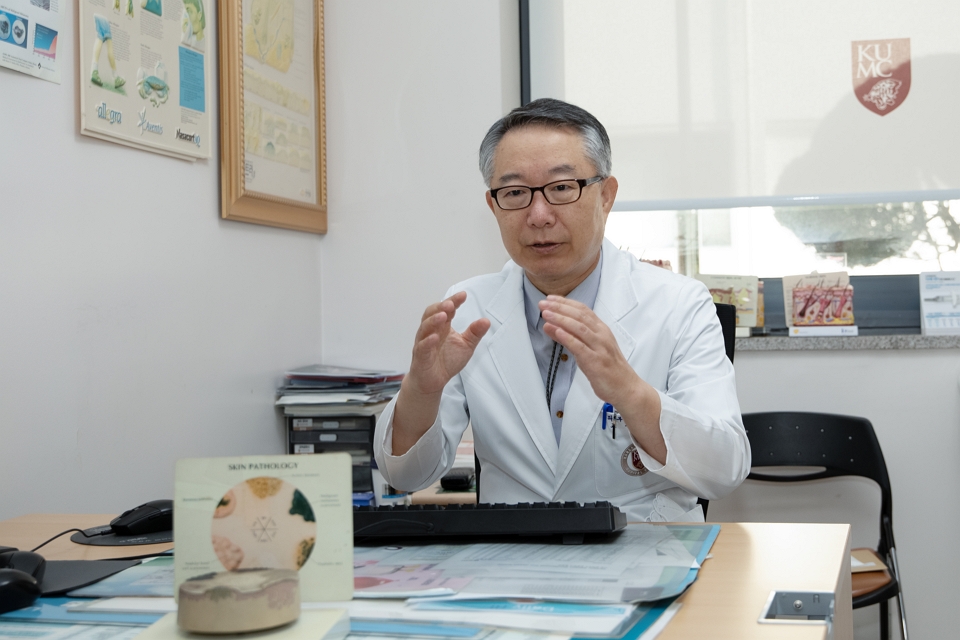‘Pay close attention to your skin and continuously check the changes’
Laypersons tend to think dermatologists are similar to cosmeticians. In extreme cases, however, people can die of skin diseases – especially if the ailment is malignant melanoma and if it spreads to internal organs.
In the past, dermatology departments stopped at diagnosing problems through biopsies and sent skin cancer patients to large university hospitals for surgery.
However, the separation of process exposed limitations in treatment consistency.
Some Korean dermatologists who went to the United States for training in the 1990s saw the situation was different there. U.S. dermatologists conducted skin cancer surgeries and carried out clinical trials, too. Skin doctors did everything in cancer treatment from diagnoses to surgeries, periodically following up the whole process.

One of the frontrunners who introduced the system to Korea and helped it take root here is Professor Kim Il-hwan of the Dermatology Department at Korea University Ansan Hospital (KUAH). Professor Kim, who started skin cancer surgery in 1997 and has since performed about 1,000 surgeries, from incisions to sutures, is a first-generation skin cancer specialist and a renowned “Mohs surgery” expert.
In a recent interview with Korea Biomedical Review, Professor Kim said skin cancer is relatively easy to treat if detected early. Even if it is malignant, hospitals can treat the symptoms with chemotherapy or drug treatment without surgery in the early stages.
However, suppose cancer has progressed to a certain extent. In that case, it is premature to conduct the surgery by only estimating the size of skin cancer based only on visible spots on the skin.
"The reason is there are many cancer cells that extend their tentacles to the depths of the body, even though the skin cancer site is small," Professor Kim said. "Even if we cut out the visible cancer site, there is a high possibility that the remaining cancer cells will cause problems down the road."
In such cases, Professor Kim stressed that Mohs surgery is the best alternative to neutralize the vicious properties of skin cancer as it is a surgical method with a high cure rate and low recurrence rate.
"Mohs micrographic surgery is a method designed to effectively and completely excise skin cancer," he said. "The skin cancer is cut out in stages, and the suspected cancerous tissue is frozen."
Afterward, the physician further excises only the area with the remaining cancerous tissue under a microscope and completely removes the root of the skin cancer while repeating the microscopic reading.
Kim noted that while the procedure takes a long time as the hospital has to freeze the cancer section and repeat readings, it can minimize the removal of normal tissues, which is important if cancer appears in the face.
"Therefore, both the hospital and patients can obtain satisfactory results in terms of cosmetics and functionality," he said.
Establishing Mohs micrographic surgery clinic was not easy
Professor Kim learned Mohs micrographic surgery from Professor Michael McCall of Louisville Medical School, one of the Mohs Fellowship training institutes in the U.S., from 1999 to 2000.
After returning to Korea, he opened the first Mohs micrographic surgery clinic at KUAH and has performed more than 800 surgeries.
However, running the clinic was not easy at first.
"During the initial stages, the hospital did not support the opening of a clinic," Km said. "I repeatedly talked about the need for such a clinic, but it was not well accepted as skin cancer was uncommon at the time."
In the end, the hospital did not oppose the process pushed by the chief of its Dermatology Department, allowing him to open the first Mohs micrographic surgery clinic in Korea.
"Even after establishing the center, it was not easy to make it fully operational," he said. "At that time, there were no set reimbursement standards for the method, and few patients were receiving the surgery, so the clinic made no financial value to the hospital."
Also, while the original Mohs micrographic surgery requires a doctor to remove the skin cancer and read the pathology slide after making a frozen section of the removed tissue and staining it, Korea's medical law allowed only pathology specialists to read slides, he added.
Kim recalled that it took him several months to persuade and convince pathologists about the need to follow the original Mohs micrographic surgery process.
Through this process, Mohs has now become the standard treatment in treating skin cancer in Korea.
"While only two hospitals conducted the operation in Korea in the beginning stages, more than 10 hospitals operate their own Mohs micrographic surgery clinic now," he said.
However, Kim noted that that there remains some room to be desired in the field.
"As the original definition of Mohs surgery requires physicians to read slide pathology during surgery, the domestic environment which does not allow such a procedure needs to change," he said. "Also, since skin cancer is curable if detected at an early stage, it is best to continue to educate both the medical workers and patients to detect symptoms early."
How to prevent skin cancer
Reiterating that early detection is the key in treating skin cancer, Professor Kim provided some advice to prevent skin cancer.
"For the early detection of skin cancer, it is important to periodically pay attention to changes in your body and continuously check the changes," Kim said. "It is especially important to check sites that are often overlooked, such as the scalp, toes, and toenails."
He added that if skin lesions such as abnormal spots appear, take pictures and check the changes every three to six months.
Kim also stressed that it is important to avoid outdoor activities on days and times when the UV index is high and apply sunscreen if unavoidable.
"It is also important to avoid exposure to risk factors that can damage the skin as much as possible, such as smoking, overwork, excessive outdoor activity, and trauma, and to keep the skin clean and moisturized," he added.

